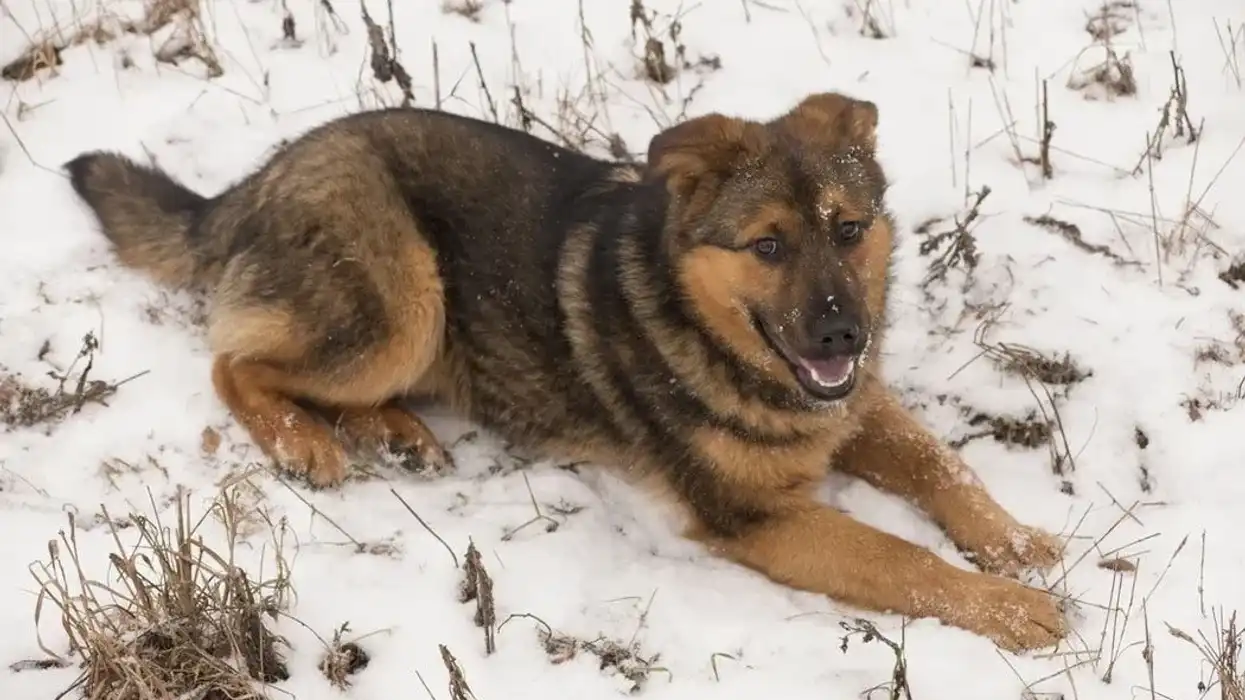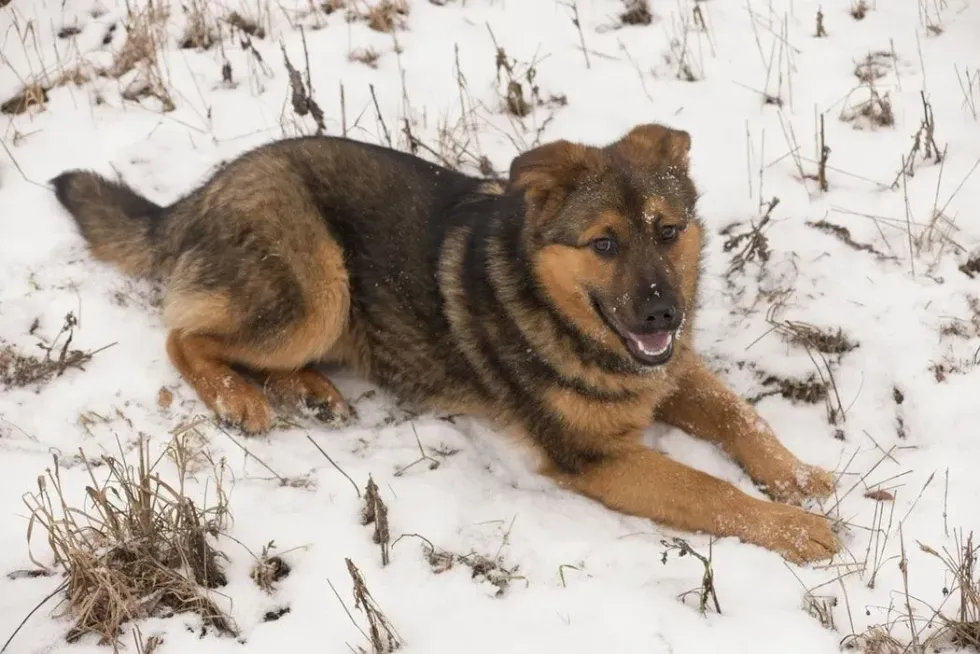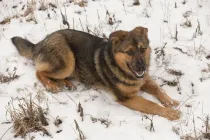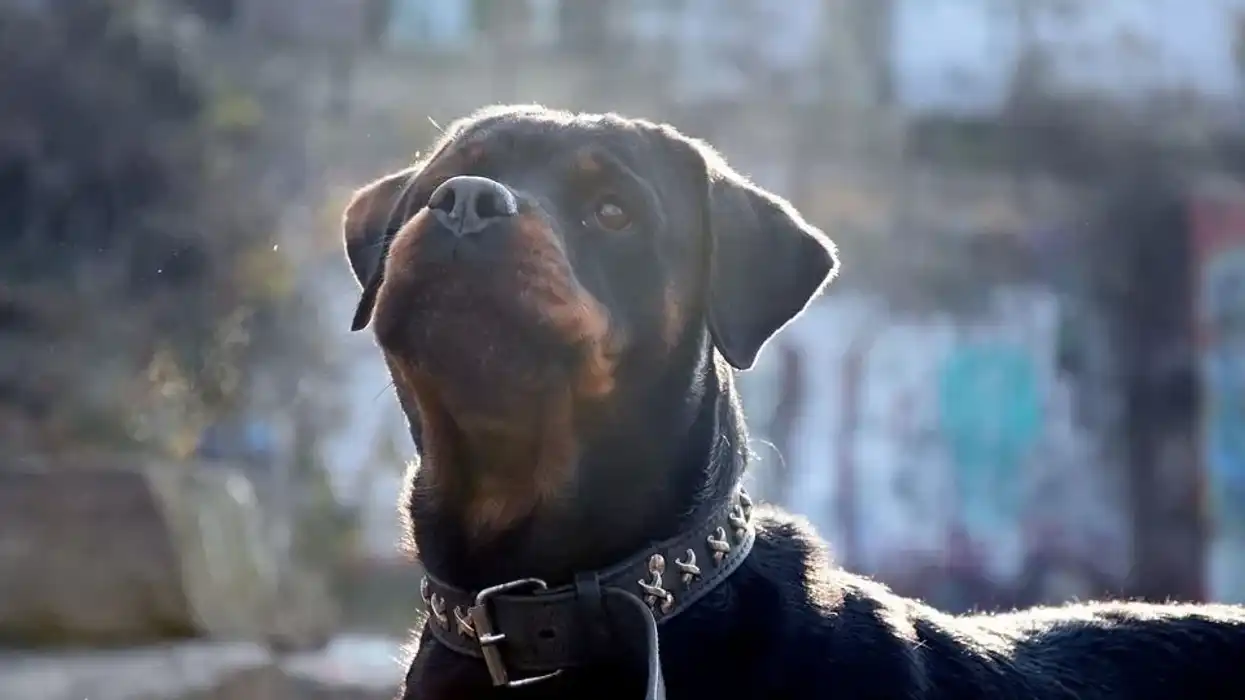Fun Miniature German Shepherd Facts For Kids

Content
- What type of animal is a miniature German Shepherd?
- What class of animal does a miniature German Shepherd belong to?
- How many miniature German Shepherds are there in the world?
- Where does a miniature German Shepherd live?
- What is a miniature German Shepherd's habitat?
- Who do miniature German Shepherds live with?
- How long does a miniature German Shepherd live?
- How do they reproduce?
- What is their conservation status?
- What do miniature German Shepherds look like?
- How cute are they?
- How do they communicate?
- How big is a miniature German Shepherd?
- How fast can a miniature German Shepherd run?
- How much does a miniature German Shepherd weigh?
- What are their male and female names of the species?
- What would you call a baby miniature German Shepherd?
- What do they eat?
- Are they slobbery?
- Would they make a good pet?
- Did you know...
- What health issues do miniature German Shepherds suffer from?
- What is a miniature German Shepherd a cross of?
Is reading and learning about newly bred designer dogs your new hobby? Then reading about miniature German Shepherds will make you very happy.
A miniature German Shepherd is exactly what the name suggests, a mini version of one of the most popular dog breeds, the German Shepherd. They mostly all look like smaller replicas of purebred German Shepherds due to their dominant genes.
They are most commonly bred with small collies or other herding dogs. They are loyal, obedient, active dogs who love working and helping their masters with their chores. The miniature versions are ideal as family dogs to smaller families.
Because of their intelligence and small size, they are trained to fantastic service dogs to blind, deaf, or someone disabled. A miniature German Shepherd puppy can cost up to $1000 or more depending on the breed of the smaller dog used.
A mini German Shepherd is half in size as a purebred one but is full of its characteristics. To know more about these beautiful species of small dogs, keep reading ahead and enjoy.
If you would like to read more about various animal facts, then please check these similar articles on the black German shepherd and the German shepherd wolf mix.
Miniature German Shepherd Interesting Facts
What type of animal is a miniature German Shepherd?
Miniature German Shepherd is a mixed breed dog.
What class of animal does a miniature German Shepherd belong to?
The mini German Shepherd breed belongs to the class of mammals.
How many miniature German Shepherds are there in the world?
It is not clear about the exact population of miniature German Shepherds as they are a comparatively new mixed breed, they are gaining more and more popularity every passing day.
Where does a miniature German Shepherd live?
Mini German Shepherds were created by mixing purebred German Shepherd dogs with another small-breed dog to get the ideal family dog or working dog who is intelligent and loyal. Thus, these dogs are trained to live in houses or apartments with their masters as a puppy.
What is a miniature German Shepherd's habitat?
A Miniature German Shepherd is a mix between the purebred dog breeds of a German Shepherd and usually a Yorkshire terrier, Corgis, or Border Collies, developed to become a great companion dog as they are loyal, obedient, and very smart capable of being excellent work or guide dogs as well.
The standard breed German Shepherds were working dogs used to herd cattle, but soon, because of their sharp senses, intelligence, extreme loyalty, obedient nature, and wolf-like features made them the second most popular dog breed in the world found as a loving family pet, or as a guide dog to the disabled and even in the police and armies as working dogs or rescue dogs.
They are mostly crossed with other herding dogs like a Border Collie which is regarded as the smartest domestic dog breed, or small-size dogs like Yorkshire terriers or Corgis who have a calm and loving nature bred to become great show dogs and family pets.
Due to their ancestral history, mini German Shepherds naturally adjust to domestic habitats like houses and apartments, and because of their smaller size, they can do well even in small houses or studio apartments although it is better for dogs to have a large area to run around in as they have high energy and need a lot of exercise.
They have a double coat which makes them adjust to extremely cold climates as well.
Who do miniature German Shepherds live with?
A Miniature German Shepherd dog, like its larger breed, lives in packs. They were bred to become the best family dog you could ask for.
As a puppy, if trained well, they will consider their family as their pack and their master as their leader. They are highly intelligent, loyal, obedient, and eager to please their master and get along well with other dogs as well with appropriate training of course.
That's why along with great family dogs they are a great working dog as well. Because of their fearless and alert nature, they are great guard dogs as well.
How long does a miniature German Shepherd live?
A miniature German Shepherd dog has an average lifespan of 13 - 15 years or more depending on its food habits and overall health.
Be sure to adopt your puppy from a reputable breeder as these newly bred designer Mini GSD are prone to a few health problems which they mostly inherit from their small-sized parent breed. Designer dog breeds like this German Shepherd mix breed are prone to problems like elbow and hip Dysplasia, Bloat (Gastric Dilatation-Volvulus), Epilepsy, Perianal Fistula, Hemophilia.
A dwarf German shepherd lives for only three or four years on average since dogs who suffer from dwarfism don't live as long as normal dogs.
How do they reproduce?
Miniature German Shepherd belongs to the designer breed of dogs.
They were bred by mixing a purebred German Shepherd with another smaller herding dog breed where the dominant genes of the GSD breed give them the German Shepherd look just a little smaller in size.
In these modern times, most breeders used live artificial insemination to developed the mini GSD breed. But they can be bred naturally as well when they reach their sexual maturity at seven months but it is advised to wait two years before breeding your mini German Shepherd dog until they reach full emotional maturity.
The gestation period for these dogs is around 60 - 65 days, after which a female gives birth to six to eight miniature German Shepherd puppies per litter.
What is their conservation status?
The Miniature German Shepherd breed is comparatively a newly-designed breed developed for serving various human needs. The breed has not been listed on the IUCN Red List (International Union for Conservation of Nature), due to lack of enough information. Also, given the breeds gaining popularity it is unclear about their exact population of the miniature German Shepherd.
Miniature German Shepherd Fun Facts
What do miniature German Shepherds look like?
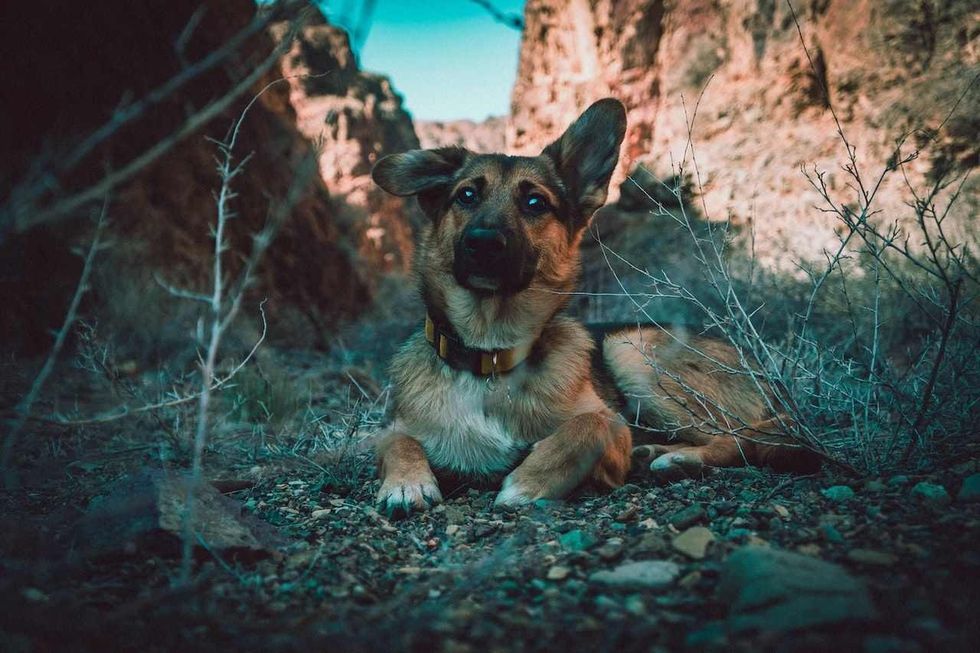
A miniature German Shepherd dog looks exactly like its larger parent breed but is half of its size. Miniature GSDs, due to the dominant German Shepherd's genes, have all the characteristics of the standard breed and more.
They have a medium-length double-coated fur with patches of black, tan, or brown, other colors are found but rarely depending on the other parent breed. Their fur can be smooth and glossy or curly depending on the cross.
There is no standard for this breed as it's a hybrid and all variations are accepted.
But to be a miniature breed, the dog should be up to 50 lb (23 kg) and height should be up to 20 in or 50.8 cm. Most of them have a long muzzle and pointed ears like wolves.
How cute are they?
A small German Shepherd with all the qualities of a purebred German Shepherd is simply the cutest and most adorable.
Although German Shepherds are amongst the most popular breeds adopted, their large size, strength, and wolf-like features make them look intimidating and scare away many.
Thus this mixed breed is considered perfect for people who want a smaller dog with similar characteristics and temperament, and they also require much lesser space, food, and exercise compared to the larger breed. They are extremely intelligent, loving, loyal, and big-time master pleasers.
They are very affectionate and have a much lower prey drive than the pure breeds and hence, they would make for great companions for families with younger children or for deaf, blind, or disabled people who live alone or for senior citizens living alone as they are great watchdogs as well.
How do they communicate?
Like all dogs, miniature German Shepherds also bark, growl, whine or wag their tails to communicate their emotions and thoughts to their human friends.
They are highly intelligent and can understand commands from their masters very quickly and obey vigilantly. As they are easy to train and communicate with and are very good at understanding their masters that they are trained to be guard dogs, companion dogs, guide gods, rescue dogs, police dogs, and army dogs as well as loving family pets.
Even though they are small, they are very energetic, playful and strong, and very protective of their family.
How big is a miniature German Shepherd?
A full-grown miniature German Shepherd is half in size as its purebred parent.
There isn't any standard size, color, or features for a German Shepherd mix as most of the crosses come out looking similar to purebred German Shepherds but their height and weight differ according to the other breed of herding dog mixed with it.
The smallest German Shepherd mix is the cross with a Yorkshire terrier. A Corgi mix German Shepherd has the appearance of a GSD but the height and body as long as a corgi.
As long as the fully grown dog is up to 50 lb (23 kg) and the height is between 15in - 20 in (38.1 cm - 50.8 cm), they would be called a miniature German Shepherd dog.
How fast can a miniature German Shepherd run?
The maximum speed of a purebred German Shepherd is around 30 mph or 48 kph which they pass over to its miniature mix as well. Due to their athletic nature and sharp senses with their small size, mini German Shepherd dogs are also being used for police work in the United States.
How much does a miniature German Shepherd weigh?
A mini German Shepherd should not weigh more than 50 lb or 23 kg, which is half of the larger parent breed and more than its smaller parent breed. A small German Shepherd mixed breed with Poodles, Pugs, Corgis, Chihuahuas, and more will weigh below 50 lb or 23 kg approximately and within 25 lb or 11.33 kg.
What are their male and female names of the species?
A male miniature GSD is called a dog and a female is called a bitch. They don't have any gender-based name specific to the miniature German Shepherd breed.
What would you call a baby miniature German Shepherd?
A miniature German Shepherd's baby is called a puppy or pup.
What do they eat?
A mini German Shepherd doesn't need the same quantities of food as its larger breed, but since it's a high-energy active dog that doesn't like laying around and wants to work, requires 30 calories per pound of body weight.
Thus on average, your miniature German Shepherd will be needing at least 1500 calories every day which is to be divided into two equal meals.
They should be given decent quality corn-free kibble high in animal protein.
A vet-prescribed or high-quality vitamin supplement is good for your dog's bone health and immunity. But remember that GSDs are very fast eaters which may make them bloat so feeding them from slow-feeding bowls is preferable.
Are they slobbery?
Miniature German Shepherd doesn't drool or slobber excessively. They are moderate droolers and mostly drool after exercise, or if they drink a lot of water or when it's mealtime.
But if your dog tends to drool more than usual it could be a symptom of any health issues that they may be facing or maybe they've swallowed something they shouldn't have.
Would they make a good pet?
The Miniature German Shepherd was created to become good companions as pets and working dogs so they would no doubt make an excellent pet for you or your family.
They have all the great qualities of an ideal service or companion dogs. They are energetic and playful, and unlike other dogs of their size don't like sleeping all day.
They have a loving and protective nature with fantastic senses which make them great watchdogs and rescue dogs utilized for detective work.
They are extremely loyal and would go to any extent to please their master and fulfill their jobs. The Miniature German Shepherd descends from a mix of herding dogs so they are very good with small kids and good companions to older children.
But they are not always very kind to strangers and can get aggressive if they feel threatened or if they sense any danger to their family or master.
As per grooming and training requirements, they are very low maintenance. But they have a thick medium to long double-coated fur and they are not at all hypoallergenic, so that means they shed a lot.
Your house is likely to get covered with its fur everywhere. So ideally they should be brushed once every day and bathed once every two or three weeks.
They are prone to few health problems which is quite common in this breed.
But beware of adopting or purchasing your Mini German Shepherd as they are prone to pituitary dwarfism where the full-grown dog might look like a miniature but is not. So make sure to contact a registered breeder and know about your dog's ancestors.
Did you know...
A Miniature German Shepherd dog has a longer lifespan than a standard German Shepherd dog.
Due to their small size, soft puppy-like coat, and fox-like facial features, a miniature German shepherd often resembles a coyote.
The pituitary dwarfism in German Shepherds can be treated if diagnosed early by porcine growth hormones.
The German Shepherd Yorkshire terrier mix is the rarest and smallest breed of miniature German Shepherds.
A miniature German Shepherd can be trained to detect low blood sugar levels or a seizure onsite.
What health issues do miniature German Shepherds suffer from?
Miniature German Shepherd does inherit a few health issues or conditions that they commonly suffer from its larger-sized parent.
The common health problems include elbow and hip dysplasia, bloating (gastric dilatation-volvulus), epilepsy, perianal fistula (caused by various food allergies), hemophilia, hypothyroidism (an underactive thyroid condition), megaesophagus (mostly seen in the weakest miniature German shepherd puppies when they start eating solid food), and degenerative myelopathy.
Due to deficiency of thyrotropin in their thyroid glands, pituitary dwarfism is also common in the weakest pups of the litter.
Most of these problems are curable with the right diet and treatment, whereas some are caused genetically and have no cure.
What is a miniature German Shepherd a cross of?
A miniature German Shepherd is a cross of purebred German Shepherds with any other smaller herding dog breeds. The most common breeds used to mix with purebred GSDs to develop this miniature version are border collies (Shollie), Poodles (Shepadoodle), Siberian huskies (Siberian Shepherd), corgis, pugs, golden retrievers, Yorkshire terriers, and many more.
Most breeders stick to other herding breeds or calm and quiet dogs to cross with German Shepherds to eliminate excessive aggression, but nowadays all sorts of mixes are accepted though not recognized by the American Kennel Club.
Here at Kidadl, we have carefully created lots of interesting family-friendly animal facts for everyone to discover! Learn more about some other mammals including the American bully and the dogo Argentino.
You can even occupy yourself at home by drawing one of our Miniature German Shepherd coloring pages.
We Want Your Photos!
More for You
Sources
https://animalso.com/breeds/miniature-german-shepherd/#:~:text=The%20Miniature%20German%20Shepherd%20isis%209%20to%2013%20years.
https://petkeen.com/miniature-german-shepherd/
https://worldofdogz.com/miniature-german-shepherd/
See All
Bachelor of Arts specializing in Journalism and Mass Communication, Postgraduate Diploma in Sports Management

Moumita DuttaBachelor of Arts specializing in Journalism and Mass Communication, Postgraduate Diploma in Sports Management
A content writer and editor with a passion for sports, Moumita has honed her skills in producing compelling match reports and stories about sporting heroes. She holds a degree in Journalism and Mass Communication from the Indian Institute of Social Welfare and Business Management, Calcutta University, alongside a postgraduate diploma in Sports Management.
Bachelor of Science specializing in Computer Science

Chandan ShuklaBachelor of Science specializing in Computer Science
With a Bachelor's degree in Computer Science from Aryabhatta College, University of Delhi, Chandan is a skilled and passionate technophile. He has completed a machine learning training program and is adept in various programming languages. He has been working as a content writer for two years while also striving to become a proficient tech professional.
Disclaimer
1) Kidadl is independent and to make our service free to you the reader we are supported by advertising. We hope you love our recommendations for products and services! What we suggest is selected independently by the Kidadl team. If you purchase using the Buy Now button we may earn a small commission. This does not influence our choices. Prices are correct and items are available at the time the article was published but we cannot guarantee that on the time of reading. Please note that Kidadl is a participant in the Amazon Services LLC Associates Program, an affiliate advertising program designed to provide a means for sites to earn advertising fees by advertising and linking to Amazon. We also link to other websites, but are not responsible for their content.
2) At Kidadl, we strive to recommend the very best activities and events. We will always aim to give you accurate information at the date of publication - however, information does change, so it’s important you do your own research, double-check and make the decision that is right for your family. We recognise that not all activities and ideas are appropriate for all children and families or in all circumstances. Our recommended activities are based on age but these are a guide. We recommend that these ideas are used as inspiration, that ideas are undertaken with appropriate adult supervision, and that each adult uses their own discretion and knowledge of their children to consider the safety and suitability. Kidadl cannot accept liability for the execution of these ideas, and parental supervision is advised at all times, as safety is paramount. Anyone using the information provided by Kidadl does so at their own risk and we can not accept liability if things go wrong.
3) Because we are an educational resource, we have quotes and facts about a range of historical and modern figures. We do not endorse the actions of or rhetoric of all the people included in these collections, but we think they are important for growing minds to learn about under the guidance of parents or guardians.
